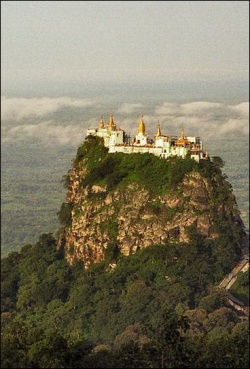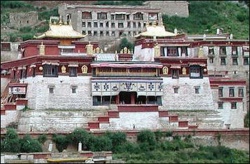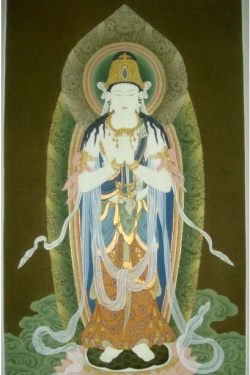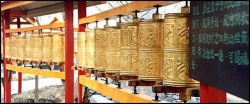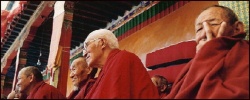Buddhist Monasteries, Monks and Pilgrims
by Jeffrey Hays
Buddhist religious Life has traditionally centered around sanghas ("Orders of Disciplines"), a word used to describe communities of Monks who preserve and transmit Buddha’s teachings and live at Monasteries. Buddhists believe that the Spiritual quest of Monks benefits the entire community and their Rituals bring prosperity and protection.
The Monk ideal is most important in Theravada Buddhism and Tibetan Buddhism. Monks have traditionally been an important part of religious Life in Theravada-dominated Thailand, Laos Myanmar, and Sri Lanka and in Tibet. Even today in these places, teenage boys and young men boys are expected to serve as Monks for period of some months, ideally after they finish school and before they get married or start a career. Most towns and even villages have own Monasteries connected to local temples. The families of Monks earn large amounts of Merit.
Monk culture is not as widespread in China and Japan and other places where Mahayana Buddhism dominated because Mahayana Buddhism does not place as much importance on the Monk ideal as Theravada Buddhism and because political pressures, namely Communism, and modern Life have discouraged men from seeking to become Monks.
Buddhist Monasteries
Buddhist Monasteries are not communal places for ordinary people to worship; they are places set aside for people who have decided to devote themselves entirely to Buddhism. Even so they are generally open to the public. Lay people are generally welcome at the Monasteries any time and sometimes even encouraged to reside there for a while.
Monasteries are often found in conjunction with temples. They have traditionally been centers of learning and quiet reflection. Up until recently, Monasteries were where young children went to learn how to read and write, and many Monks served as teachers.
In medieval times Buddhist Monasteries played a role that was similar to their counterparts in Europe. They helped to educate people and provided medical care and places to stay for travelers and orphans. Through gifts and patronage they were able to amass great Wealth and large land holdings and even open up pawnshops and banks. Sometimes Monasteries were like fortresses and had their own armies.
Monasteries usually consist of main prayer hall, dormitories, a library, schoolrooms, a rooms for Buddha statues and religious objects and a crematorium. Some famous ones are as opulent as palaces. Others are simple village facilities. The Monks sleep in small austere rooms or dormitories and meditate inside rooms, sometimes filled with smoke from candles and Incense burners, and chant in low moaning voices to the rhythm of stick striking an instrument that looks like a wooden cowbell.
Buddhist Monastery Structure and Hierarchy
Monasteries are set up as places for Monks to live, pray and work. Unlike Christian churches, which are often hierarchical institutions that emphasize community worship and social service, Monasteries are generally democratic and anti-authoritarian institutions run for Monks by Monks, who keep the Monastery going with donations and money earned from presiding over important ceremonies.
Local Monasteries are essentially self sufficient and rely on their own lands and support from the local lay community. Property belongs to the community. The religious practices are passed down from generation to generation from student to teacher.
Theravada Buddhism traditionally has not had an overarching theocratic structure like the Vatican nor are No1 leader like the Pope or Dalai Lama. Each country where Theravada Buddhism where is found has its own organization that does not extend beyond the national level. Thailand's chief Buddhist monk is known as the Supreme Patriarch.
Even the Dalai Lama is not really a leader of Tibetan Buddhism rather he is the highest-ranking Monk at Tibetan Buddhism’s main Monastery in Tibet. The hierarchies tend to exist mostly on the Monastery level with abbots or senior Monks serving as leaders of the Monastery. Their rank in turn is based on the history and prestige of the Monastery and the number of Monks that are there.
Buddhist Monks
Buddhist Monks are often known in their own cultures by a word that means "sharer." A large portion of the Buddhist cannon consists of doctrines attributed to The Buddha on how Monks are supposed to behave and what they were supposed to do. Traditionally Monks have renounced all personal possession and sexual relations and relied on the Charity of lay-people for necessities. Temples and Monasteries are paid for with donations and fees paid to Monks for performing Funerals and other ceremonies.
In Buddhist societies, Monks are generally respected by everyone and most families have a son who is Monk or was a Monk at one time. Monks are given free Food and often allowed to ride free on buses and trains. Even the girlie bars and brothels on Patpong Road in Bangkok welcome saffron-robed Monks who show up periodically recite Mantras and make Blessings to ensure good profits.
In Tibetan Buddhism and some other sects, Monks Retreat to Caves or remote huts to meditate and live as hermits. But generally most Monks live in a community with other Monks in a Monastery. Theravada Buddhism devotes a great deal of literature to Monks and their role in the Monk community and society as a whole. In Mahayana Buddhism, there is more emphasis on pursing individual Enlightenment.
Few Monks are Monks their entire lives. Those that are often become scholars, teachers, and healers. Some specialize in folk magic and even work as astrologers. Many spend much of their time presiding over Funerals.
Monks are free to a leave anytime they want. In Southeast Asia, many young men often serve a few weeks as a Monk as a sort of coming of age rite, and then resume their ordinary lives. Undisciplined children are sometimes taken to Monasteries by parents to set them straight.
Purpose and Aims of a Buddhist monk
On one hand Monks are perceived as sort of mini-Buddhas in that not only are they seeking Enlightenment for themselves but devote a great amount of energy and devotion to teach and inspire and instruct other to purse the Way of The Buddha. One the other hand, they remain seekers of Knowledge themselves, or ones who has not found Nirvana but are still striving for and have things to learn and achieve, and are advancing in a gradual, step-by-step process.
Monks are not removed from World. They spend a large amount of their time in Monastery schools teach children reading and Writing as well Religion. This is one reason why many Buddhists countries have traditionally had a high rate of literacy. Buddha himself chose not spend his time on Earth in an Enlightened state; rather he decided to be in the real World, teaching people About Buddhism.
The first reward fir a fully-realized Monk is to escape being reborn as an animal or a Ghost or Caste into a Buddhist Hell. The is regarded as the first stage of entering the stream that flows towards Nirvana. The next stage is to reach such a level that Attachment to World is a minimal and one has to endure only one more human birth to reach Nirvana. In the last stage the Monk experiences Nirvana and transcends Life on Earth, breaks the cycle of Reincarnation and has no reason to be reborn.
History of Buddhist Monks
The first Buddhist Monks were called arhants . They were regarded as men well on their way down the Path to seeking Nirvana. One passage from an early Buddhist text goes: “Ah, happy indeed the Arhants! In them no Craving’s found. The ‘I am’ conceit is rooted out; confusion’s net is burst. Lust-free they have attained; translucent is the Mind of them. Unspotted in the World are they...all cankers gone.”
The first Five ascetics who became the first Monks under The Buddha were joined by 55 others. They together with The Buddha are known as the 61 arhants. The were ordained by The Buddha by repeating the simple phrase: “Come Monk; well-taught in the Dharma; fare the attainment of Knowledge for making a complete anguish.” Others that came later were ordained after cutting their Hair and beard, donning a robe and uttering three times: “I go to The Buddha for Refuge, I go to Dharma for Refuge, I go to The Sangha for Refuge.” This Ritual remains the basis of the Theravada Monk ordination process today.
Aanada was The Buddha Constant companion. His two chief disciples—Sariputta and Moggallana—were two Ascetics who for were known for seeking the Dharma to deathlessness Mahkaccan was ranked the highest for his ability to interpret The Buddha’s brief statements.
In the years that followed The Buddha gave more sermons and instructed his disciples on methods that could be used to discover the eternal Truth. The Buddha spoke on a number of subjects and often used stories about monkeys, wealthy lords and fishermen and similes such as comparing “hold of the Mind” to “trainer’s hook” used to pacify a “savage elephant” to make his points. He presented himself as a man not a God of myth and thereby argued that anyone could achieve what he had done.
Buddhist Nuns
There is no equivalent of the order of Monks for women. Women can serve as lay nuns but they are much lower status than Monks. They are more like assistants. They can live at temples and generally follow fewer rules and have less demands made on them than Monks. But aside from the fact they don’t perform certain ceremonies for lay people such as Funerals their lifestyle is similar to that of Monks.
Nuns spend much of their time in Meditation and study like other Monks. Sometimes nuns shave their heads, which sometimes makes them almost indistinguishable from the men. In some cultures their robes are the same as the men (in Korea, for example, they are grey) and other ones they are different (in Myanmar they are orange and pink). After the head of a Buddhist nun is shaved, the Hair is buried under a tree.
Buddhist nuns perform various duties and chores. Nuns-in-training make around 10,000 Incense sticks a day working at easel-like desks at a building near the Pagoda. carol of Lufty wrote in the New York Times, "The women, all in their 20s and exceedingly friendly...wrap a sawdust-and -tapioca flour mixture around pink sticks and roll them in yellow powder. These are then dried along the roadside before they are sold to the public."
At one time there was a nun movement in which nuns had a similar status of Monks but this movement has largely died out.
Buddhist Lay People
The is strong supportive relationship between the Monk community and lay people. With lay men and women providing Monks with Food, lodging and medicine for Monks and Monks giving them Dharma in return.
Lay people are supposed to follow the basic tenets of Buddhism and provide alms to Monks and temples. They are considered a lower incarnation than Monks and are not required to spend as much time praying and meditating as Monks.
Buddhist texts describe the relationships between parents and children, husbands and wives, employers and employees, etc., and also describe to some degree how these people are supposed to behave to one another.
Buddhist Pilgrims
Buddhist pilgrims make pilgrimages to important religious sites such as Buddha's birthplace, major temples and Caves, Sacred mountains, and Stupas with important Buddhist relics inside them. Buddhist pilgrims often carry Lotus blossoms, and show reverence by bowing and holding their hands together in a praying position.
See Tibetan Buddhism
